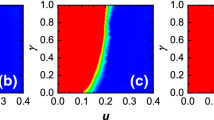Abstract
The stable allocation problem is one of the broadest extensions of the well-known stable marriage problem. In an allocation problem, edges of a bipartite graph have capacities and vertices have quotas to fill. Here we investigate the case of uncoordinated processes in stable allocation instances. In this setting, a feasible allocation is given and the aim is to reach a stable allocation by raising the value of the allocation along blocking edges and reducing it on worse edges if needed. Do such myopic changes lead to a stable solution? In our present work, we analyze both better and best response dynamics from an algorithmic point of view. With the help of two deterministic algorithms we show that random procedures reach a stable solution with probability one for all rational input data in both cases. Surprisingly, while there is a polynomial path to stability when better response strategies are played (even for irrational input data), the more intuitive best response steps may require exponential time. We also study the special case of correlated markets. There, random best response strategies lead to a stable allocation in expected polynomial time.







Similar content being viewed by others
References
Abraham DJ, Levavi A, Manlove DF, O’Malley G (2008) The stable roommates problem with globally-ranked pairs. Int Math 5:493–515
Ackermann H, Goldberg PW, Mirrokni VS, Röglin H, Vöcking B (2011) Uncoordinated two-sided matching markets. SIAM J Comput 40:92–106
Baïou M, Balinski M (2002) Erratum: the stable allocation (or ordinal transportation) problem. Math Oper Res 27:662–680
Blum Y, Roth AE, Rothblum UG (1997) Vacancy chains and equilibration in senior-level labor markets. J Econ Theory 76:362–411
Blum Y, Rothblum UG (2002) “Timing is everything” and marital bliss. J Econ Theory 103:429–443
Chen B, Fujishige S, Yang Z (2016) Random decentralized market processes for stable job matchings with competitive salaries. J Econ Theory 165:25–36
Dean BC, Munshi S (2010) Faster algorithms for stable allocation problems. Algorithmica 58:59–81
Diamantoudi E, Miyagawa E, Xue L (2004) Random paths to stability in the roommate problem. Games Econ Behav 48:18–28
Fleiner T (2014) On stable matchings and flows. Algorithms 7:1–14
Ford LR, Fulkerson DR (1962) Flows in Networks. Princeton University Press, Princeton
Gale D, Shapley LS (1962) College admissions and the stability of marriage. Am Math Mon 69:9–15
Goemans MX, Li EL, Mirrokni VS, Thottan M (2006) Market sharing games applied to content distribution in ad hoc networks. IEEE J Sel Areas Commun 24:1020–1033
Gusfield D, Irving RW (1989) The Stable Marriage Problem: Structure and Algorithms. MIT Press, Cambridge
Hoefer M, Wagner L (2014) Matching dynamics with constraints. In: Liu T-Y, Qi Q, Ye Y (eds) 10th International Conference on Web and Internet Economics (WINE). Springer International Publishing, pp 161–174
Klaus B, Klijn F (2007) Paths to stability for matching markets with couples. Games Econ Behav 58:154–171
Knuth D (1997) Mariages stables. Les Presses de L’Université de Montréal, 1976. English translation in Stable Marriage and its Relation to Other Combinatorial Problems, volume 10 of CRM Proceedings and Lecture Notes. American Mathematical Society
Kojima F, Ünver M (2008) Random paths to pairwise stability in many-to-many matching problems: a study on market equilibration. Int J Game Theory 36(3–4):473–488
Millán B, Risma EP (2018) Random path to stability in a decentralized market with contracts. Soc Choice Welf 51(1):79–103
Roth AE, Vande Vate J H (1990) Random paths to stability in two-sided matching. Econometrica 58:1475–1480
Wang X, Agatz N, Erera A (2017) Stable matching for dynamic ride-sharing systems. Transp Sci 52(4):850–867
Zwick U (1995) The smallest networks on which the Ford–Fulkerson maximum flow procedure may fail to terminate. Theor Comput Sci 148(1):165–170
Acknowledgements
We would like to thank Péter Biró, Tamás Fleiner, and our reviewers for their valuable comments.
Author information
Authors and Affiliations
Corresponding author
Additional information
Publisher's Note
Springer Nature remains neutral with regard to jurisdictional claims in published maps and institutional affiliations.
A short version of this paper has appeared in the proceedings of SAGT 2014, the 7th International Symposium on Algorithmic Game Theory. This work was supported by the Cooperation of Excellences Grant (KEP-6/2018), by the Ministry of Human Resources under its New National Excellence Programme (ÚNKP-18-4-BME-331), the Hungarian Academy of Sciences under its Momentum Programme (LP2016-3/2016), its János Bolyai Research Fellowship, OTKA grant K128611, and the Cluster of Excellence MATH+ (EXC 2046/1, project ID: 390685689).
Rights and permissions
About this article
Cite this article
Cseh, Á., Skutella, M. Paths to stable allocations. Int J Game Theory 48, 835–862 (2019). https://doi.org/10.1007/s00182-019-00664-6
Accepted:
Published:
Issue Date:
DOI: https://doi.org/10.1007/s00182-019-00664-6




